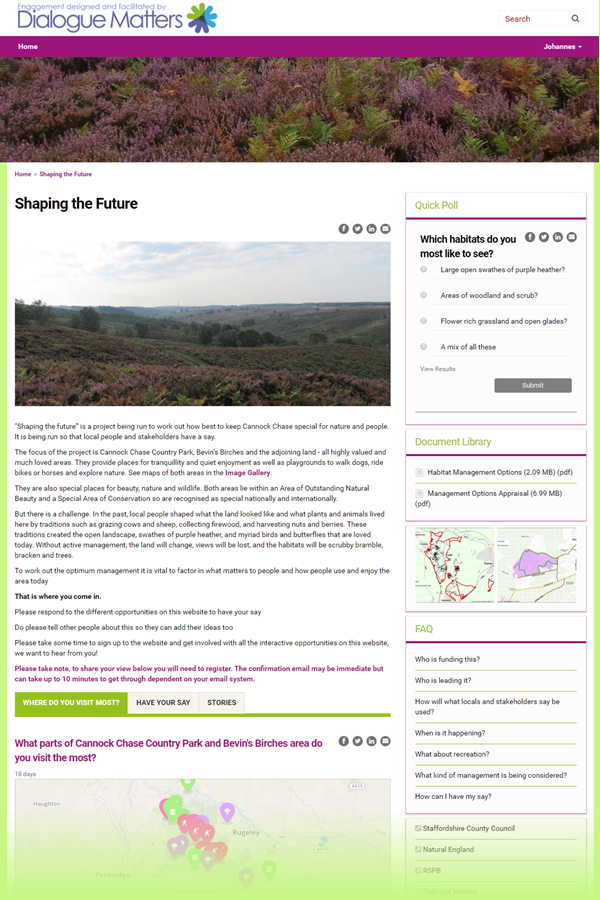EHQ Staff Pick: Managing Cannock Chase, By Dialogue Matters, UK
Our presence in the UK is growing steadily and it was only a matter of time until a project from Great Britain would make it as our staff pick. A few have been on our radars for a while and the 'Shaping the Future' consultation, run by Dialogue Matters, has finally been the pick of the bunch. The consultation is around managing Cannock Chase - a country park in the heart of England - and about understanding how people use this beautiful strip of nature. Read why we like it below. 
Client: Dialogue Matters
Template: Torquay, bypassing the homepage
Project: Shaping the Future
Publish Date: 10 October 2016
Topic: "Shaping the future" is a project being run to work out how best to keep Cannock Chase special for nature and people. It invites local people and stakeholders to have their say.
Tools: Places, Stories, Survey, Quick Poll
Widgets: Signup Banner, Quick Poll, Document Library, Photo Gallery, FAQ, Important Links
We love:
-
Places: Undoubtedly the hero of this project. Participants are asked to place pins on areas of the country park they visit the most. To do this, they can choose between seven different categories, all with their own colour and icon, which is a new option in our revamped Places tool.
The team has decided to ask people to register before they can place a pin, which is a great way to build a community. Once registered, participants can place pins anywhere on the map and the team has enabled the option to upload photos to pins. This is also a new feature of Places and perfect for a consultation of this nature (pun intended). Not many participants have uploaded photos though. Maybe the fact that photos can be added could have been emphasized and encouraged in the tool description.
-
Accompanying documents: Two documents are uploaded to the project page. While the bigger of the two is quite complex and long, the smaller file is showing a simple overview of the 'Habitat Management Options'. Both the design and language in this document are simple and therefore easy to understand.
-
Plain language: Similar to the document mentioned above,plain language is used throughout the entire site. The project description is kept simple, as are the FAQs as well as the language used in the survey. Sticking to plain language is important to ensure your entire audience, which may come from a variety of different education levels and technical understanding of the consultation topic, are feeling confident to have their say.
- Stage of engagement: As outlined in the opening paragraphs, in this stage of the consultation it is very much about understanding "...what matters to people and how people use and enjoy the area today." The tools in use - Places, Stories, Quick Poll and Survey - work well to achieve this goal and they are all framed openly to invite people to share their experiences and preferences. It is all designed for the consultation team to get a better understanding of what role the region plays in people's lives.
For further consideration:
Colours: The primary colours on this site are green and purple, which represent the dominant colours of the region's nature. For that reason they work well, but it does take a moment to get used to.
- Length of text: The project description, albeit written in simple language, is fairly long. The team may want to consider shortening the text or truncating the description. Both actions would ensure the tools move further up the page and are visible to participants without scrolling.
OVERALL: Our first pick from the UK is testament to the growing presence of online community engagement and the ever increasing quality of consultations. We love to see Places being used to allow people to share their experiences and with pins from seven different categories, it adds even more colour to an otherwise already very colourful and bright project page. We are looking forward to seeing the subsequent stages of this consultation unfold.
NOTE: The article above is based on a visit to the site on 26 October 2016. Changes made to the project after that date may have altered the appearance of the project.
